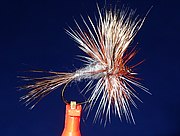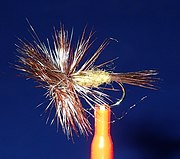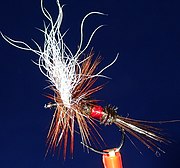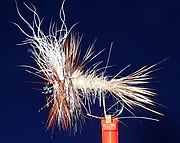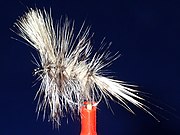Origin
In 1930, Lee Wulff designed three innovative dry flies to fish with on the Esopus and other Catskill rivers. He called the flies the Ausable Gray, Coffin May and Bucktail Coachman. They were high floating, full bodied flies with hair wings and tails. They proved exceptionally effective for trout and salmon in fast rivers. At the time, he was fishing regularly with Dan Bailey, a science teacher at Brooklyn Polytechnic. Both men were tying and selling flies in their spare time to supplement their incomes. Wulff considered the traditional English and Catskill style dry flies that were the staple of the fly trade were far too skinny and "anemic" to be effective for American trout thus he created this stocky, robust style of fly. [1] Angling author Joseph D. Bates Jr. in his seminal work on Atlantic Salmon Flies and Fishing (1970) credits Wulff with "establishing a distinct American style of dry fly." [2]
He collaborated with Dan Bailey during the development of the patterns and Bailey encouraged him to rename the flies. The original Ausable Gray, Coffin May and Bucktail Coachman became the Grey Wulff, White Wulff and Royal Wulff. Three additional patterns were created by the end of 1930, the Blonde Wulff, Brown Wulff and Black Wulff. The series would gain prominence after Wulff introduced them to Ray Bergman, another fly angler and outdoor writer who became the Fishing editor for Outdoor Life magazine. Bergman embraced the flies and included them his two editions of Trout (1938, 1952). [1]
The Wulff flies were designed by Lee Wulff and fill a decided need in large sizes. I consider them necessary to the well-balanced fly box. New Wulff patterns, Black Wulff and Grizzly Wulff [designed by Dan Bailey] have been added to my color plates because they are considered very important by fishermen in the Rockies as well as other sections.
—
Ray Bergman, Trout (1952) [3]
Wulff considered the pattern somewhat generic and encouraged variation and evolution of the pattern instead of rigid adherence to a precise recipe. Dan Bailey, who fished regularly in Montana and eventually established a fly shop and mail order business in Livingston, Montana in 1938 promoted the series extensively to western fly anglers. The Wulff flies, especially the Royal Wulff, are still a staple in angler's fly boxes around the world. [4] Angler and writer John Gierach believes the Royal Wulff is one of the most popular dry patterns over the last half century. [5]

Fly tying is the process of producing an artificial fly used by fly fishing anglers to catch fish. Fly tying is a manual process done by a single individual using hand tools and a variety of natural and manmade materials that are attached to a hook. Although the recent history of fly tying dates from the middle 1800s, fly tyers were engaged in tying flys since at least 200 AD.

The Woolly Bugger is an artificial fly commonly categorized as a wet fly or streamer and is fished under the water surface. It is a popular and widely used pattern for both freshwater and saltwater game fish and is generally listed as one of the top patterns to have in any fly box. John Gierach, a noted fly fishing writer discussed the Woolly Bugger first in his chapter on streamers in Good Flies. Woolly Buggers are typically fished in streams, rivers, ponds, lakes, and tidal flats. Today, Woolly Buggers are tied in a wide variety of styles and colors to imitate a wide range of game fish prey.
The Woolly Bugger is so effective, it should be banned from some watersheds. I suspect its effectiveness is due to its resemblance to so many edible creatures in the water—nymphs, leeches, salamanders, or even small sculpins. Its tail undulating behind a fiber, bubble-filled body is just too much for most fish to resist. It just looks like a meal!

An artificial fly or fly lure is a type of fishing lure, usually used in the sport of fly fishing. In general, artificial flies are an imitation of aquatic insects that are natural food of the target fish species the fly fishers try to catch. Artificial flies are constructed by fly tying, in which furs, feathers, thread or any of very many other materials are tied onto a fish hook.
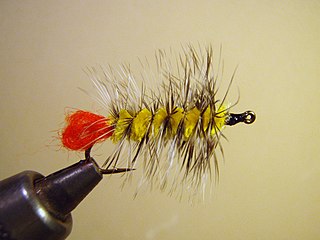
The Woolly Worm is an artificial fly commonly categorized as a wet fly or nymph and is fished under the water surface. It is a popular pattern for freshwater game fish and was a very popular fly in the 1950s–1970s in the west. Charles Brooks in Nymph Fishing for Larger Trout recommends the Woolly Worm as a general purpose nymph pattern in most western trout waters in any fly box. Woolly Worms are typically fished in streams, rivers, ponds, and lakes for trout, bass, and panfish. Today, Woolly Worms are tied in a variety of styles and colors to imitate a large aquatic nymphs such as stoneflies, dragonflies, damselflies or hellgrammites.
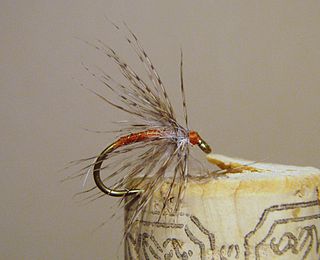
The Partridge and Orange is an artificial fly commonly categorized as a wet fly or soft hackle and is fished under the water surface. The fly is a very well known fly with its roots set firmly in English angling history. It is an impressionistic pattern fished successfully during caddis hatches and spinner falls. The Partridge and Orange is traditionally a trout and grayling pattern but may be used for other aquatic insect feeding species.

The Royal Coachman is an artificial fly that has been tied as a wet fly, dry fly and streamer pattern. Today, the Royal Coachman and its variations are tied mostly as dry flies and fished floating on the water surface. It is a popular and widely used pattern for freshwater game fish, particularly trout and grayling. Large streamer versions are also used for winter steelhead and Atlantic salmon.

Dan Bailey was a fly-shop owner, innovative fly developer and staunch Western conservationist. Born on a farm near Russellville, Kentucky, Bailey is best known for the fly shop he established in Livingston, Montana in 1938. Dan Bailey's Fly Shop is still in business.
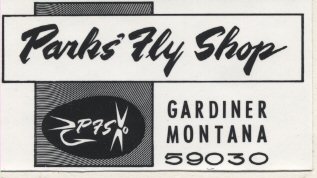
Parks' Fly Shop is a fly shop and licensed fly fishing outfitter in Gardiner, Montana. In business since 1953, the shop located at 202 2nd Street between Main and Stone is the oldest business in Gardiner under continuous family ownership.
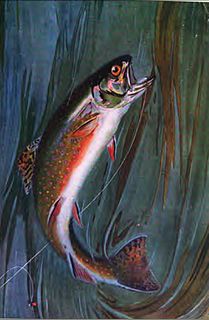
This annotated bibliography is intended to list both notable and not so notable works of English language, non-fiction and fiction related to the sport of fly fishing listed by year published. Although 100% of any book listed is not necessarily devoted to fly fishing, all these titles have significant fly fishing content. Included in this bibliography is a list of species related fly fishing literature.
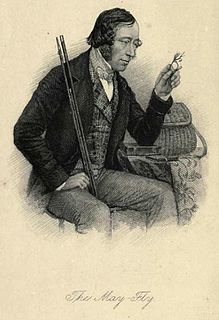
This annotated bibliography is intended to list both notable and not so notable works of English language, non-fiction and fiction related to the sport of fly fishing listed by year published. Although 100% of any book listed is not necessarily devoted to fly fishing, all these titles have significant fly fishing content. Included in this bibliography is a list of fly tying, fly tackle, regional guides, memoirs, stories and fly fishing fiction related literature.
Lee Wulff, born Henry Leon Wulff, was an artist, pilot, fly fisherman, author, filmmaker, outfitter and conservationist who made significant contributions to recreational fishing, especially fly fishing and the conservation of Atlantic Salmon.

The Royal Wulff is a popular artificial fly used for dry fly fishing. It is an attractor pattern and a descendant of both the Royal Coachman fly and the Wulff style of hair wing flies named for Lee Wulff.
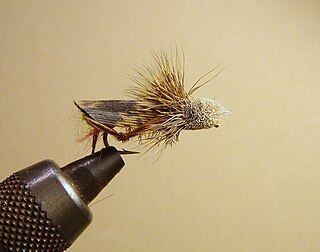
Dave's Hopper is an artificial fly used for fly fishing, designed to imitate adult grasshoppers and other Orthoptera species. It is considered a dry fly terrestrial pattern. It was designed by fly tyer and angler Dave Whitlock, and combines the best aspects of Joe's Hopper and Muddler Minnow patterns.

Parks' Salmonfly is a traditional dry fly imitating adults of the family of giant stoneflies or salmonflies (Pteronarcyidae). The most commonly imitated species is Pteronarcys californica or salmonfly common throughout Western North America from British Columbia to California.

The Stimulator is a dry fly popularized by angler, fly tyer and author Randall Kaufmann to imitate large adult stoneflies.

The Red Tag is an artificial fly originally designed as a dry fly for grayling and trout in the north country of England. The fly pattern, when introduced into Australia, particularly Tasmania, became extremely successful and popular for brown trout and remains today as one of the most essential flies for Australian fly anglers.

The Brown Bi-visible is an attractor style dry fly first promoted by angler Edward Ringwood Hewitt in his work Telling on the Trout (1926). A generic, high floating pattern, the fly was designed to provide visibility of the fly for the angler in low light conditions. Darker colored flies were extremely difficult to see in low light and glare conditions. The addition of light cream colored or white hackle at the front of the darker body made the Bi-visible easier for the angler to see on the water. Ray Bergman in his seminal 1952 work Trout gave the following credit to the Bi-visible pattern:
I gave Bivisible flies complete and indisputable credit. I believe that I even intimated they were the last word--the ultimate in dry flies. I was so sold on the Bivisibles for one complete season that if trout wouldn't take one, I figured they wouldn't take anything, and I was perfectly satisfied with this decision.
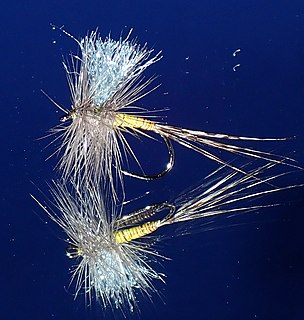
Blue-winged Olive flies is a collective term used by anglers in fly fishing to identify a broad array of mayflies having olive, olive-brown bodies and bluish wings in their adult form. Sometimes referred to as BWO , a wide array of artificial flies are tied to imitate adult, nymphal and emerging stages of the aquatic insect. While the family Baetidae probably has the most species identified as blue-winged olives, another mayfly family Ephemerellidae also contains some. Collectively, blue-winged olive mayflies are an important food source in most trout streams, thus their widespread imitation by fly tiers.

Salmon fly patterns are an important collection of artificial flies used by fly anglers to imitate nymphal and adult forms of Pteronarcys californica a giant stonefly or salmon fly. Salmon flies are common in high gradient, freestone rivers and streams from Western Canada throughout the Western U.S. to Mexico in the Rocky Mountains and coastal mountain ranges. Nymphs live for three to five years before adult emergence which typically occurs in late Spring or early summer. The long lifespan of the nymphal form provides year-round angling opportunities for fly anglers.

Terrestrial flies are a broad group of artificial flies used by fly anglers to imitate terrestrial insects that fall prey to fish in rivers, streams and lakes. Most typical are patterns imitating grasshoppers, crickets, ants, beetles, leaf hoppers, cicadas and moths.

